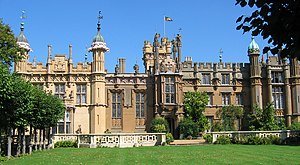Batman (1989 film)
The tone and themes of the film were partly influenced by Alan Moore and Brian Bolland's The Killing Joke and Frank Miller's The Dark Knight Returns.
[7] Nicholson accepted the role of the Joker under strict conditions that dictated top billing, a portion of the film's earnings (including associated merchandise), and his own shooting schedule.
Reporter Alexander Knox and photojournalist Vicki Vale investigate sightings of "Batman", a masked vigilante targeting Gotham City's criminals.
Both attend a fundraiser hosted by billionaire Bruce Wayne, who is secretly Batman, having chosen this path after witnessing a mugger murder his parents when he was a child.
Meanwhile, mob boss Carl Grissom sends his sociopathic second-in-command Jack Napier to raid Axis Chemicals and retrieve incriminating evidence.
Sometime later, Gordon announces that the police have arrested all of Joker's men, effectively dismantled what remained of Carl Grissom's mafia organizations, and unveils the Bat-Signal.
Batman leaves the police a note, promising to defend Gotham should crime strike again, and asking them to use the Bat-Signal to summon him in times of need.
The success of The Dark Knight Returns and the graphic novel Batman: The Killing Joke rekindled Warner Bros.' interest in a film adaptation.
[1] Parallel to the Superman casting, a variety of Hollywood A-listers were considered for the role of Batman, including Mel Gibson, Kevin Costner, Charlie Sheen, Tom Selleck, Bill Murray,[5][13] Harrison Ford and Dennis Quaid.
[23] Burton was pressured by Warner Bros. to cast an obvious action movie star,[7] and had approached Pierce Brosnan, but he had no interest in playing a comic book character.
[25] Producer Jon Peters suggested Michael Keaton, arguing he had the right "edgy, tormented quality" after having seen his dramatic performance in Clean and Sober.
[29] Tim Curry, David Bowie, John Lithgow, Brad Dourif, Ray Liotta, and James Woods were all considered for the Joker.
[19][30][31][32] Lithgow, during his audition, attempted to talk Burton out of casting him, a decision he would later publicly regret, stating, "I didn't realize it was such a big deal.
[45] Irish child actor Ricky Addison Reed was cast as Dick Grayson before the character was removed by Warren Skarren for the revised shooting script.
[46] The rest of the cast included Pat Hingle as Commissioner Gordon, Jerry Hall as Alicia, Lee Wallace as Mayor Borg, William Hootkins as Lt. Eckhardt, and Jack Palance as crime boss Carl Grissom.
"On Batman, our vision of Gotham City was influenced by the tone of the 'Dark Knight' comics, and also Andreas Feininger's photographs of New York buildings and the work of Japanese architect Shin Takamatsu.
"[11] Furst and the art department deliberately mixed clashing architectural styles to "make Gotham City the ugliest and bleakest metropolis imaginable".
Ringwood found it difficult designing the Batsuit because "the image of Batman in the comics is this huge, big six-foot-four hunk with a dimpled chin.
Ultimately, Keaton decided to perform Batman's voice at a lower register than when he was portraying Bruce Wayne, which became a hallmark of the film version of the character, with Christian Bale later using the same technique.
Jon Peters reworked the climax without telling Burton and commissioned production designer Anton Furst to create a 38-foot (12 m) model of the cathedral.
"[7] Elfman enlisted the help of composer Shirley Walker and Oingo Boingo lead guitarist Steve Bartek to arrange the compositions for the orchestra.
[16] Kim Newman theorized that "Burton and the writers saw Batman and the Joker as a dramatic antithesis, and the film deals with their intertwined origins and fates to an even greater extent".
In the end Burton and producers decided on only using a gold and black logo designed by Anton Furst and airbrushed by Bill Garland, with no other key art variation, to keep an air of mystery about the film.
[5] Jon Peters unified all the film's tie-ins, even turning down $6 million from General Motors to build the Batmobile because the car company would not relinquish creative control.
The website's critical consensus reads, "An eerie, haunting spectacle, Batman succeeds as dark entertainment, even if Jack Nicholson's Joker too often overshadows the title character.
Executive producers Benjamin Melniker and Michael E. Uslan filed a breach of contract lawsuit in Los Angeles County Superior Court on March 26, 1992.
Melniker and Uslan claimed to be "the victims of a sinister campaign of fraud and coercion that has cheated them out of continuing involvement in the production of Batman and its sequels.
In the series, Batman has mysteriously disappeared after Dent's death, leading Gotham citizens to take to the streets to fight in his place, including Barbara Gordon, who becomes Batgirl.
Scarecrow and Harley Quinn will be featured as the main antagonists,[131] seemingly referencing the unproduced fifth film in the Burton and Schumacher series, Batman Unchained.
In an unprecedented move at the time, it was made available to buy on VHS in the United States on November 15, less than six months after its theatrical release, at a suggested retail price of only $24.95 although most sellers sold it for less.


